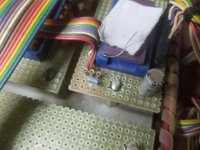Dwight Elvey
Veteran Member
I was just thinking, you may want to follow A5 from the RAM since the counter may be a 4 bit counter rather than more. A0 to A3 would be on the same counter while A4 to A5 would be on the next counter.
A5 comes from the RAM pin2 and goes to pin 12 of the left '157. The same rule applies for pin 13 and 14.
Dwight.
A5 comes from the RAM pin2 and goes to pin 12 of the left '157. The same rule applies for pin 13 and 14.
Dwight.

